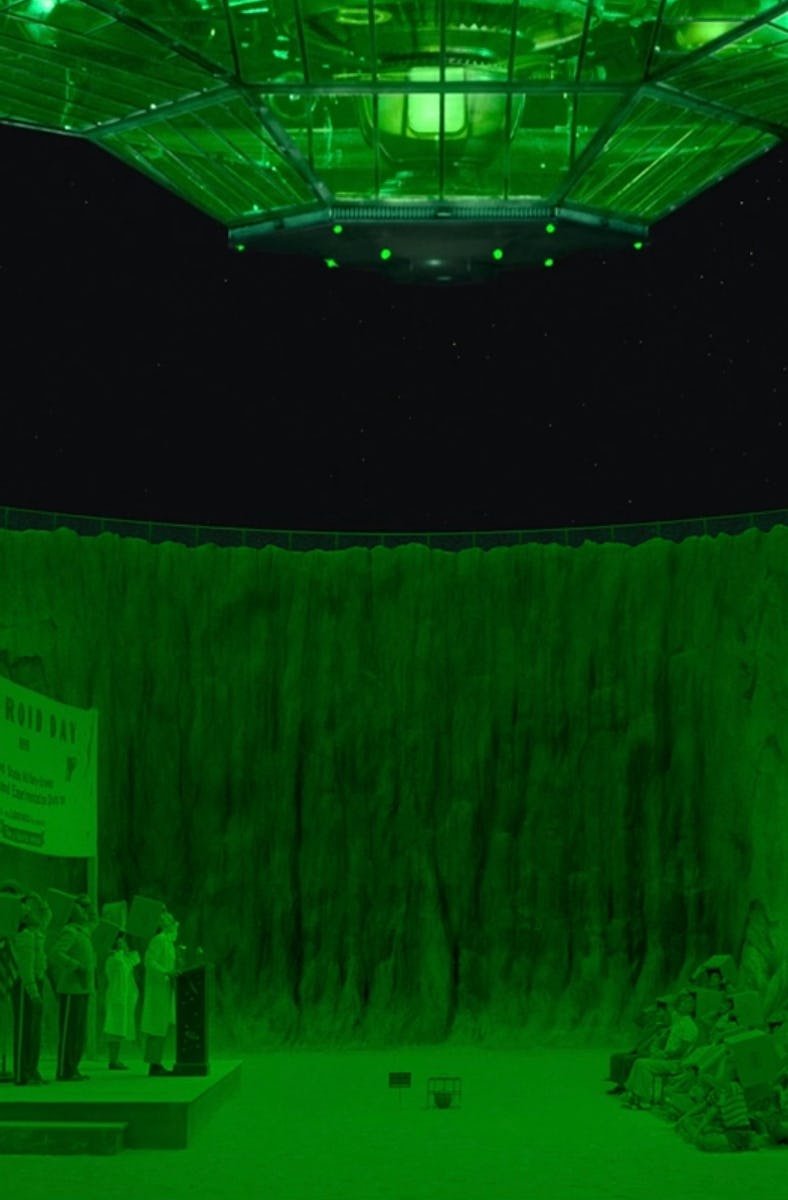The Best Sci-Fi Movie of the Year Tries to Make Sense of a Vast Universe
“I still don’t understand the play.”

The universe is a vast and overwhelming place. Like life, it’s as beautiful and invigorating as it is horrifying and paralyzing. The same is true of any attempts to try and uncover the secrets of it — most of which have a habit of leading you down endless rabbit holes or, worse yet, headfirst into oft-repeated clichés. Does the fact that the universe is, in and of itself, too big and complex for anyone to wrap their head around mean that we all should give up on trying to, though?
That question is at the heart of the year’s best sci-fi film, Asteroid City. Writer-director Wes Anderson’s latest effort is a multilayered, puzzle-like dramedy that bridges the future-forward era of midcentury America with the curiosity-driven period of reinvention and exploration that shook up the Broadway world (and Hollywood) in the 1950s. In doing so, Asteroid City posits, among other things, that it may be just as easy to get lost in art as it is to get lost in life.
The film, which ranks high as one of 2023’s very best, is now available to stream on Amazon Prime Video. If you haven’t seen it yet, there’s no better time than now to catch up on it.
Asteroid City, like The Grand Budapest Hotel and The French Dispatch before it, is yet another one of Wes Anderson’s experiments in nesting-doll storytelling. Trying to succinctly describe its plot is, therefore, a foolhardy endeavor, but the gist of it is this: The film follows the cast and crew of a TV recreation of the making of a play known as “Asteroid City.” It, consequently, bounces between two different levels of reality. The movie’s black-and-white sections reveal how “Asteroid City” was originally made and performed, while its color sections represent the performance of the play itself.
It’s confusing and it’s also not. Anderson and cinematographer Robert Yeoman use enough visual cues to make it easy to keep up with the film’s different realities, and Anderson trusts his audience’s intelligence enough to not spend too much time relitigating the specifics of Asteroid City’s odd structure. The film puts the emotions of its characters first — the new grief felt by Jason Schwartzman’s Augie Steenbeck, the loneliness of Scarlett Johansson’s Midge Campbell — and it succeeds because of that. Anderson fills Asteroid City with characters whose lives are in various degrees of turmoil, traps them all in the same fictional American desert town (and play), and then confronts them with the unknowability of the universe.
Within Asteroid City’s eponymous play, he does so by bringing them face-to-face with a literal alien, who arrives unexpectedly one night to retrieve a rock that fell to Earth years prior. Schwartzman’s Augie, already reeling from the recent loss of his wife, takes the alien’s arrival as a sign that life on Earth is meaningless or, at the very least, doomed. Outside of Asteroid City’s play, Anderson explores the struggles of its actors and its director, Adrien Brody’s Schubert Green, all of whom feel so close to the material and yet incapable of fully understanding it. Eventually, these issues come to the forefront of Asteroid City in a third-act scene between Schwartzman and Barbie star Margot Robbie that is among the best that Anderson has ever created.
Jason Schwartzman turns in the best performance of his career in Asteroid City.
Across its Broadway-set scenes and its reality-shattering sci-fi trip to a one-stop American town, Asteroid City introduces questions about art and the universe that it purposefully doesn’t answer. Nor should it. Asteroid City is more concerned with highlighting the beauty of emotional and scientific exploration than it is in trying to bring its characters’ stories to neat and tidy conclusions. It’s a film that is overflowing with beautiful moments, all of which celebrate the messiness of life, art, and the simple but difficult act of trying to grapple with our place in the universe.
Asteroid City knows that the search for meaning never really ends. The film itself doesn’t conclude, either, so much as it stands by and watches as its characters move on to another town, another chapter, another play. Like the Celestial Ellipsis that its characters observe one night, which has the power to burn its lights onto the eyes of anyone who looks directly at it, Asteroid City is an anomaly — a film composed with clear, unparalleled precision and intention that celebrates the beauty of ambiguity. At first, it may seem too disconnected to comprehend, but subsequent rewatches reveal that it has more going on beneath its surface than almost any other movie this year.
Asteroid City is streaming now on Amazon Prime Video.